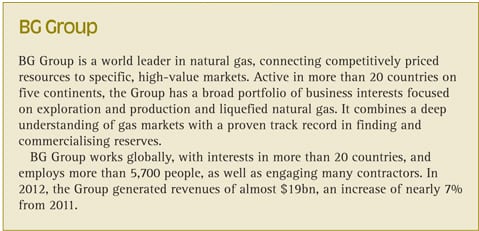After the Ballots
How the ‘year of elections’ reshaped treasury priorities
Published: November 01, 2013

BG Group plc has experienced a remarkable transformation since privatisation in 1986, and its demerger from British Gas plc in 1997. The company has now developed into a high growth global E&P and LNG business with a market capitalisation of around $60bn. This was achieved by generating consistently strong cash revenues as a result of its ambitious and successful growth strategy. Over the past three years BG Group has entered a major investment phase and this resulted in substantial changes to the balance sheet: for example, as the company noted in its first quarter results last May, it now has a net debt position of $10.6bn and $4.2bn in surplus cash. Consequently, the company had to devise and implement changes to its funding strategy, as Pedro Zinner discusses in this article.

We have an efficient treasury function at BG Group, covering a wide range of funding, investment, risk and cash management responsibilities. To ensure that our activities are aligned with industry best practices and the needs of the business, we frame our activities within a series of core treasury objectives:
i) To implement an optimal debt structure that is aligned with our five-year business strategy and which enables us to optimise our capital structure and cost of funds;
ii) To adopt the most appropriate cash management techniques to effectively allocate resources and optimise cash balances;
iii) To enhance the integrity, accuracy and control of our processes and information flows.
With a change to market conditions and perceptions of risk since the global financial crisis and a shift in our borrowing requirements, financing the business in a sustainable and cost-effective way is clearly a key priority. When devising our funding strategy, we have a number of key considerations to enable us to achieve this.[[[PAGE]]]
A critical requirement is the long-term commitment to a solid credit rating: therefore, our funding decisions should be made within the framework of conditions set out by the major credit rating agencies. A strong rating is essential to enable us to compete in the international arena as a partner of choice. Balanced with our long-term commitment to maintaining our credit standing are a variety of other considerations. For example, funding solutions should be cost-effective and closely aligned with our investment cycle. While long-term financing is most important to meet our strategic objectives, the ability and readiness to access capital remains a priority to prevent liquidity constraints during periods of uncertainty. We also recognise that our strategy needs to be consistent with banks’ new capital adequacy requirements and the evolving geo-economic and geo-political risk picture.
To meet these requirements, we devised a funding strategy to balance our long-term credit rating objectives, cost efficiency and diversification. For example, to manage costs efficiently, we engage in active liability management and dynamic portfolio rebalancing. To ensure appropriate diversification, not only do we leverage a variety of funding sources and types of instrument but we also access a diverse investor base wherever possible.
In the light of the global financial crisis beginning in 2008 and the more recent euro economic crisis, the consequent impact on the global financial markets has resulted in periods when access to traditional sources of funding, such as debt capital markets and bank loans, have been significantly impaired. Looking ahead to the future, access could again become restricted, or, depending on the type of structure, cease altogether due to a more stringent regulatory environment. Less traditional sources of corporate funding, such as Export Credit Agencies (ECAs), National Development Banks (NDBs) and Multilateral Agencies/Banks (MLAs/MDBs), are alternative funding vehicles to support corporate growth. At a time when few institutions were lending during the global financial crisis, the Multilateral Development Banks provided $222bn in financing, which was critical to global stabilisation efforts.
With this in mind, Treasury has focused on the diversification of funding sources in 2012, with a particular focus on ECAs and NDBs.
In April 2012, a US$500m credit agreement was signed with Export Development Canada (EDC). The agreement has an initial term of four years with the option to extend for an additional 12 months. It is supported by BG Group’s existing relationships with Canadian service providers and will encourage BG Group to examine other potential procurement opportunities for Canadian goods and services across the Group’s global portfolio.
A cooperation agreement between BG Group and the Japan Bank for International Cooperation (JBIC) aimed at potential projects that would supply energy resources to Japan was also signed in October 2012.
Finally, in December 2012, the Group secured a $1.8bn loan facility from US EX-IM. This is subject to final documentation and the export of US services and equipment for the ongoing delivery of the QCLNG project in Australia.
The committed bank facilities are the Group’s principal source of committed liquidity. They act as backstop facilities (as required by rating agencies) for issuance of commercial paper, and as emergency liquidity in the event of general market disruption or inability to access the market for some other reason.
In 2012, in light of the Group’s sizeable capex programme and the potential for further periods of uncertainty in the bond markets, as well as the increased focus of rating agencies and investors on liquidity, the quantum of the Group’s committed facilities was increased and the maturity extended.
In November 2012 BG closed a new committed multicurrency syndicated bank facility to replace US$2.3bn of expiring bilateral facilities. The size of the new facility amounted to US$3.04bn and represents an increase in BG Group total bank committed facilities of approximately US$700m. Total undrawn bank committed facilities now stand at $5.2bn, of which $2.3bn expires in 2016, and $3.04bn expires in 2017.
It has been possible for some time now to lock in long-term funding from the debt capital markets at attractive rates of interest. In order to strengthen our capital structure, increase diversification of funding types, demonstrate management commitment to maintaining a high credit rating and access a competitively priced type of long-term funding, hybrid bonds (achieving 50% agency equity credit) were issued in June 2012, extending the average maturity of our gross borrowings to around 17 years.
The hybrid issue was well received by the market (awarded 2012 Investment Grade Corporate Bond by International Financial Review/Reuters and Europe Corporate Bond of the Year by The Banker), raising some US$2.1bn in total from the three currency tranches, with the books significantly oversubscribed. This indicated a very clear endorsement of BG Group’s plans to deliver on the significant growth opportunities within our global portfolio and also in our funding diversification programme.
Not only have we been engaged in an extensive investment programme over the past three years, but we expect this to continue over the next two years, so finding innovative and appropriate means of financing the business will continue to be a priority. Most companies, including BG Group, are pre-funding their capex plans, anticipating their strategic direction in advance and leveraging on the current levels of market liquidity. Furthermore, despite a focus on long-term financing, the global financial crisis emphasised that short-term liquidity cannot be ignored, and cash shortfalls can be pose challenges to the business. We will continue to refine and develop our funding strategy to meet our short-term liquidity needs and longer- term strategic plans, serving the needs of our customers, shareholders and employees.
